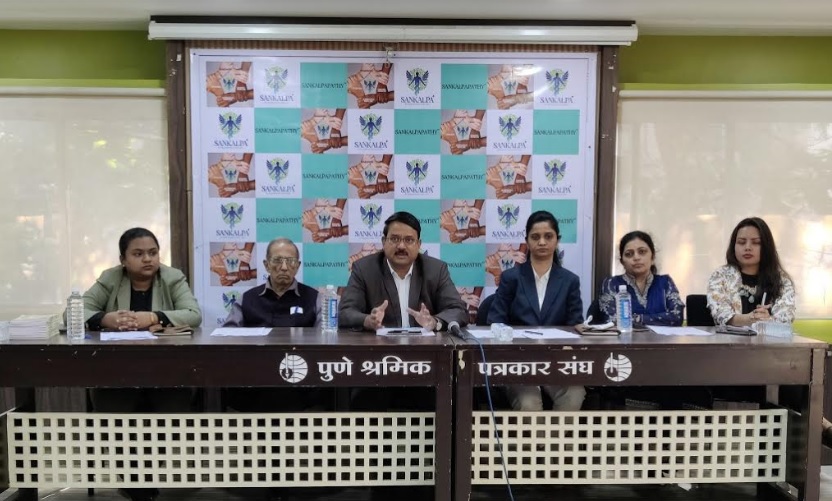Pune, Maharashtra, India
Considering the special features of each medical system as well as its limitations without opposing any other medical system. The new ideal integrated model of medical system that is “Sankalppathy” has been initiated. This medical system is now become the need of a 21st Century.
 |
Sankalpa’s Head of Research and Development Department Sharwari Dombe, Prof. Subhash Patke, Dr. P.N. Kadam, Dr. Apoorva Ahirrao, Dr. Manisha Kadam, Dr. Prachiti Punde
“Sankalpapathy” is a way of thinking where patients can certainly benefit from the efficiency of each medical system if they try to use it hand in hand, understanding each other. “Sankalpapathy” is an integrated medical system that seeks to integrate Allopathy, Ayurveda, Homeopathy, Naturopathy and Human Psychology. that’s why it is necessary to use the Sankalppathy as a preferable medical choice, as advised by Former Medical Administrative Officer and Director of Sankalp Human Resource Development, Dr. P.N. Kadam (M.B.B.S., MS (Psy)).
Dr. P.N. Kadam was Speaking at a press conference on the issue of pathology in the medical field. Director of ‘Sankalp‘ organization Dr. Apoorva Ahirrao, Dr. Manisha Kadam, Head of Research and Development Department Sharwari Dombe, Dr. Prachiti Punde, former principal Subhash Patke was also present at the press conference. The press conference was moderated, welcomed and thanked by Dr. Prachiti Punde.
“Sankalpapathy” is a philosophy of an integrated medical model system, not just one that prescribes a specific method of teaching medicine, such as allopathy or homeopathy.
Dr. Kadam said, “In the 21st century, it is important to consider the physical, mental, emotional and social condition of an individual. Therefore, by adopting the concept of integrated medical model system, the experts in the field should suggest diagnosis and appropriate treatment from his point of view, but while doing so, he should be aware of the limitations and certainty of his disease.”
Dr. Kadam further added, “After analyzing the evolving needs of both preventive and therapeutic medicine, I have come to the conclusion that any so-called treatment that is unable to restore the normal physiology of the organ is only temporary. Like every Indian, I believe in our indigenous medicine system, which focuses on the Ayurveda science of life, the mind and body for good health. In addition to that we have the inner wisdom of homeopathy and naturopathy, as well as modern day psychological tools and we have an integrated system that looks at the human body from a different perspective.”
Dr. Apoorva Ahirrao said, “How to get to the root of the disease and how to cure the disease from the root are the features of “Sankalpapathy”. It is an innovative experiment in the field of medicine along with the three sutras of diet, lifestyle and thought. From dengue to aplastic anemia and from gallbladder to heart, it is time to write a new chapter in the 21st century with ‘Sankalpapathy‘.”
Sharwari Dombe said, “The medical field is changing very fast with new diagnostic machines and laboratory tests, there seems to be little difference in treatment. 2020 is a turning point in the medical field. While many antibiotics are literally retiring, many of the most commonly used drugs will become banned medicine. Statins, nimesulide, and the recently released anticide Ranitidine, Rabeprazole, and Pantoprazole are just the beginning.”
‘Sankalpapathy’ is an experiment that gives a new direction to the medical field which is confused as to which doctor to trust and by the referrals of specialists and super specialists.
Former Principal Subhash Patke said, “In the context of Corona, disputes in the medical field are under serious discussion today. Many medical systems are proving how superior we are, how important our dominance is by which disputes are arising. Homeopathy and Ayurveda doctors are practicing allopathy and other such things are under constant discussion. At the same time, there is a demand to combine all the medical system and create mixopathy. But the demand for ‘mixopathy‘ is wrong.”
Why Integration of Different Pathies
The foundation of Sankalpa is to support every different pathy creating an integrated approach of complementary systems that support and enrich each other in helping the patient achieve long term cure. We would like to urge the Human Mankind to keep an open mind and freely take everything that’s good, fine and rational from every pathy…
This change in approach and attitude will broaden the horizons of our thought, understanding and knowledge about the human body. Start a cross-talk between different pathies to form a truly futuristic model for the Health of a New Era. Sure enough, while everyone has the full right to follow different philosophies, a fundamental truth will always remain: Nature is the biggest healer-and we have to connect ourselves to nature in Ahara – our diet, Vihara -i n our rest and recreation and Vichara-our thought process.
How Sankalpapathy works
Sankalpapathy works on a new concept of “Integration” of different branches of Medicine.
Main Objective: To provide “Whole Person Healing” (WPH) and Root cause elimination of the disease.
Sankalpapathy will help any doctor in three types of problems that doctor faces in medical practice –
When doctor has faced the problem where, he has suggested so many investigations but diagnosis is not arriving or diagnosis is there however now facing the limitations and there is confusion in the treatment or patient is under treatment since long, however, there is no or poor response.
Sankalpa request the doctor to help your patient with “Sankalpapathy”. Doctor should not claim to cure disease but should restore the health.
Sankalpa defines the basic categories of the disease as –
- Primary or Psychological
- Secondary or Psychosomatic.
- Tertiary or Somatic
- Terminal or Organic failure
Disclaimer: The above press release comes to you under an arrangement with Newsvoir India and this publication takes no editorial responsibility for the same.)
















